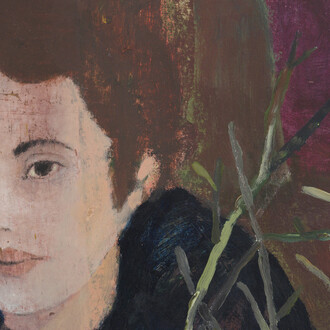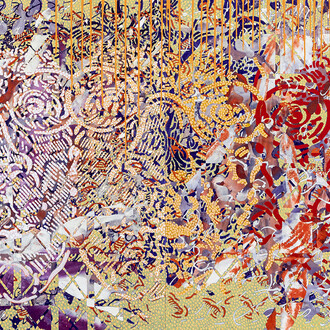The prints in Quayola's "Remains" series and his video "Jardins d’été" explore a new way of representing the natural landscape along the lines of the pictorial tradition of the late 19th century to early 20th century avant-garde.
Through his 3D scans of trees and plants, flowers and leaves, acquired in the gardens of the Château de Chaumont-sur-Loire, the artist explores a new practice of landscape representation in which individual sensibility confronts the neutral and objective gaze of the machine.
This interdependence between the artist and his technological equipment is played out in several stages: like an outdoor painter, the artist moves through places of natural interest, equipped with highly sophisticated tools that capture a maximum of data. Data collection on the spot is followed by a phase of photographic work in the studio: an exploration and selection of the digital raw matter that the artist has captured at the source. The often imperfect material with which the spectator is confronted is the astonishing outcome of an impossible encounter between a very complex natural geometry and the inability of the machine to capture this incommensurability.
Quayola's research inhabits this interstice: it’s all about the challenge represented by the limits of the machines that are used to record data. A far cry from the hyperrealism of contemporary visual culture, based on simulacra, Quayola's images gravitate towards abstraction through their internal flaws. What does this aesthetic of dysfunction reveal about the subject's relationship with nature and the world?
In "Parallel I-IV" the German artist Harun Farocki has suggested that reality will soon cease to be the standard by which we judge the supposedly imperfect image. Instead, the virtual image will become the standard by which we measure the imperfections of reality.
If the painters of modern gardens, from Monet to Kandinsky, from Matisse to Dufy, have used nature and its peaceful and disinterested observation as a means towards the expression of subjective states, this detachment is now compromised by the new paradigm of Anthropocene. In this alternative history of the Earth, marked by the advent of the human species as a geological force that has brought about irreversible changes, "nature is no longer what is embraced from a far away point of view, where the observer could ideally jump to see things “as a whole”, but the assemblage of contradictory entities that have to be composed together " (Bruno Latour, Waiting for Gaia, 2011).
For centuries literature and philosophy have insisted on the ontological divide between the poles of human and non-human, nature and the subject who is trying to know and dominate it: this insurmountable distance has made possible the feeling of the sublime.
What happens to the sublime in the age of Anthropocene? How can we represent a nature that is no longer incommensurable if, as Hans Blumenberg has suggested, this shipwreck in which life on earth seems to be at stake has “no spectator”?
In the preliminary stage, Quayola's digital equipment only records 3D points. Later, in the studio, the artist explores and selects different aggregates of the recorded spatial coordinates. It is precisely from this idea of assemblage that we must think, understand and represent the world: as an original and hybrid composition of nature, culture, subjects and objects, human and non-human.
To adapt to this new world, we will need new ideas, new myths, a new conceptual grasp of reality, and therefore a new way of representing it.
This "collaborative survival", will require a world where "science fact and speculative fabulation will need each other" (Donna Haraway, Staying with the trouble, 2016), a world in which data will only make sense through the filter of art and human sensitivity, and new aesthetics will help us to define reality.
Text by Valentina Peri
















